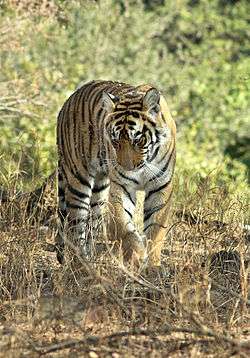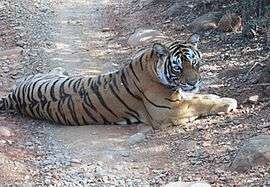Ranthambhore National Park
Ranthambhore National Park, also spelled Ranthambore, is a national park and tiger reserve in the Sawai Madhopur district in Rajasthan state in western India.

Understand
Ranthambhore National Park is closed for visitors during the monsoon season between July and September of every year.
The 275-km² park is one of the best places in India to see tigers in the wild. It is one of the most filmed wildlife reserves in the world and is also home to animals such as jackal, mongoose, sloth bear, leopard, sambar, chital, nilgai, gazelle, boars, mongoose, Indian Hare, monitor lizards, and plenty of birds. It includes 300 species of trees, 50 aquatic plants, 272 birds, 12 reptiles including the Marsh Crocodile & amphibians and 30 mammals. It also contains abandoned fortresses and lakes. Ranthambore was declared a wildlife sanctuary in 1955 and became part of Project Tiger in 1973. The number of tigers living in the park has increased from 25 to 61, but remains low, primarily due to poaching.
Its deciduous forests were once a part of the magnificent jungles of Central India.
Get in
There are no direct air, bus, or train connections to the park; however, there are train and bus stops in the nearby town of Sawai Madhopur, where connections can be made to most of the major cities in Rajasthan and beyond.
Get around
The best way to get around the park is to arrange a vehicle-based safari or a jungle walk with a local guide. Prices are negotiable.
See

- Bakula: Ranthambore wildlife sanctuary is mostly covered with thick forest. Bakula is one of the thickly forested regions. Bakula region has various pools and water holes as well as a dense forest part, due to the forest cover and easily available water, abundance of wildlife is easily found in the Bakula Region. Tourists can easily see tigresses with their young cubs near the water holes. Bakula dense forest is an excellent place for tigresses and their young cubs to hide.
- Jogi Mahal: This fort is among the must watch places in Ranthambore national park. This fort is located near to the park and offers amazing facilities to the tourists, to make their journey more comfortable.
- Kachida Valley: Kachida Valley has many outcrops and low hills. This valley is located near to outskirts of Ranthambore national park. Tourists should go through Jeep Safari, while exploring this area. Panther population of Ranthambore National Park is found here, they avoid venturing in the main area of jungle, which avoids their conflicts with tigers. Beers are also found in a good number here.
- Lakarda Anantpura: Lakarda Anantpura is located in the north and north-west part of the Ranthambhore National Park. This area is an ideal location to visit Sloth Bears. Tourists can also find lots of ant hills, which are a favourite of bears. It's a rare chance to visit these bears, but Hyenas and their pugmarks can be easily seen over here.
- National Park (Ranthambore National Park), Rajasthan (Sawai Madhopur). Ranthambore National Park located in Sawai Madhopur district of Rajasthan is one of the most visited wildlife parks in India. The main attractions of Ranthambore National Park are its tiger and bird population. The main faunas of Ranthambore are Tigers, Leopards, Striped Hyenas, Sambar deer, Chital, Nilgai, Common or Hanuman langurs, Macaques, Jackals, Jungle cats, Caracals, Sloth bears, Black bucks, Rufoustailed Hare, Indian Wild Boar, Chinkara, Common Palm Civets or Toddy cat, Coomon Yellow Bats, Desert Cats, Fivestriped Palm Squirrels, Indian False Vampires, Indian Flying Foxes, Indian Foxes, Indian Gerbilles, Indian Mole Rats, Indian Porcupines, Longeared Hedgehogs, Ratels, Small Indian Mongoose, Small Indian Civets and Common mongoose. Various species of reptiles are also found in this park.
- Ranthambhore Fort, Ranthambhore (13 Km from Sawai Madhopur Railway station). Founded in 944 and initially named "Ranath Bhawar Garh" which means "a place of Rajput warriors". The history of Sawai Madhopur revolves around the Ranthambore Fort, which is surrounded by Vindhyas and Aravallis, amidst vast and arid denuded tracts of Rajasthan. The fort is listed on the UNESCO World Heritage list.
Do
Wildlife safaris
To enter the park, you must have an approved guide and vehicle. Safaris are available either in the morning (6AM to 10:30AM) or in the afternoon (2PM to 7PM).
The park is divided into 10 zones. There is a quota for how many vehicles and visitors are allowed in each zone at any given time. The majority of the tigers live in zones 1 through 5. Zone 6 has a few tigers, but limited other wildlife, and Zone 8 (Balas) does not contain much wildlife, but it does include some beautiful temples. It is advisable to book ahead to make sure you get a ticket for zones 1-5. Safaris can be booked either online via the websites of various tour operators, at area hotels, or at the ticket window at the park entrance, which opens every day at 5AM (although prepare for long queues). You will have to show your passport when booking a safari, unless you are an Indian national, in which case your identification card will suffice.
There are two types of vehicles used for safaris, both of which are open-top, all wheel drive vehicles:
- Gypsys seat up to 6 people.
- Canters seat 16-20 people and operate on either diesel or petrol.
Expect to pay ₹500-600 per person for the safari. There is an extra charge for using videography equipment, but no extra charge for camera use.
Buy
There are many places to buy locally-produced handicrafts in the nearby town of Sawai Madhopur.
Eat
There are no eating options within the park. However, there are plenty of places to eat in the nearby town of Sawai Madhopur.
Drink
There are no bars or cafes within the park. However, there are plenty of places to drink in the nearby town of Sawai Madhopur.
Sleep
There are no accommodation options within the park itself. Visitors to the park typically stay in the nearby town of Sawai Madhopur.
Stay safe
It is necessary to take warm things (including gloves, caps, fur-coats and blankets) for the safaris in winter since it is very cold before sunrise and after sunset and you will drive in an open vehicle.
Go next
Sawai Madhopur is the town directly outside of the park and connections can be made from there to most of the major cities in Rajasthan.